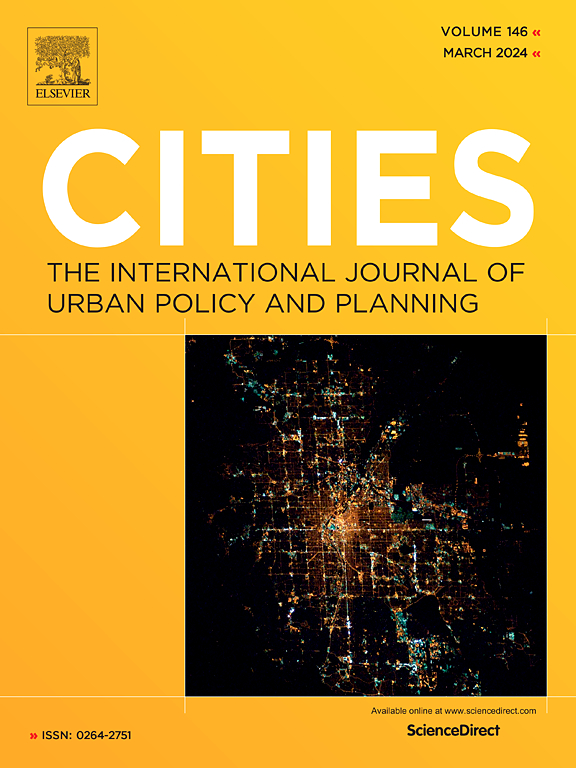Visible environment and invisible label: Does stigmatization exist in old communities in Hangzhou, China?
IF 6.6
1区 经济学
Q1 URBAN STUDIES
引用次数: 0
Abstract
Old residential communities in Chinese cities are byproducts of urbanization and often suffer from poor living conditions and other negative issues. Due to prolonged neglect in maintenance and management, these communities are susceptible to external stigmatization. However, existing research rarely examines the effect of stigma on housing prices in such neighborhoods. To address this gap, this study explores the influence of stigmatization on housing prices in old urban communities, with a particular emphasis on the mediating role of the neighborhood environment. Utilizing street view image data and deep learning methods, this study constructs six indicators of the neighborhood environment: greenness, openness, walkability, imaginability, enclosure, and complexity. Based on these indicators, a hedonic pricing model and a mediation effect model are developed to empirically examine the complex relationships among old communities, neighborhood environment, and housing prices. To address the potential limitations of linear models, a robustness check was conducted by using a Gradient Boosted Decision Tree (GBDT) model combined with SHAP analysis. The results indicate that a significant stigma effect exists in old communities, leading to an overall decline in housing prices by 11 %. Further analysis reveals that this stigma effect can be categorized into a direct effect of psychological labeling (−9.6 %) and an indirect effect mediated by environmental factors (−1.4 %). The non-linear model produced highly consistent results, with the indirect effect mediated by the neighborhood environment accounting for 16.7 % of the total effect. These findings highlight the dominant role of social perception over physical conditions in shaping housing prices. The study offers empirical support for stigma theory in urban housing markets and provides practical implications for neighborhood regeneration strategies.
看得见的环境与看不见的标签:中国杭州的老社区是否存在污名化?
中国城市的老旧住宅区是城市化的副产品,往往存在恶劣的居住条件和其他负面问题。由于长期忽视维护和管理,这些社区容易受到外界的污名化。然而,现有的研究很少考察耻辱对这些社区房价的影响。为了解决这一差距,本研究探讨了旧城社区中污名化对房价的影响,特别强调了邻里环境的中介作用。利用街景图像数据和深度学习方法,构建了绿色度、开放性、可步行性、可想象性、封闭性和复杂性六个邻里环境指标。在此基础上,构建了享乐定价模型和中介效应模型,实证考察了老旧社区、邻里环境与房价之间的复杂关系。为了解决线性模型的潜在局限性,使用梯度增强决策树(GBDT)模型结合SHAP分析进行鲁棒性检查。结果表明,老社区存在显著的污名效应,导致房价总体下降11%。进一步分析表明,这种柱头效应可分为心理标签的直接效应(- 9.6%)和环境因素介导的间接效应(- 1.4%)。非线性模型得到了高度一致的结果,邻域环境介导的间接效应占总效应的16.7%。这些发现突出了社会观念在塑造房价方面的主导作用,而不是物质条件。本研究为城市住房市场污名化理论提供了实证支持,并为社区更新策略提供了实践启示。
本文章由计算机程序翻译,如有差异,请以英文原文为准。
求助全文
约1分钟内获得全文
求助全文
来源期刊

Cities
URBAN STUDIES-
CiteScore
11.20
自引率
9.00%
发文量
517
期刊介绍:
Cities offers a comprehensive range of articles on all aspects of urban policy. It provides an international and interdisciplinary platform for the exchange of ideas and information between urban planners and policy makers from national and local government, non-government organizations, academia and consultancy. The primary aims of the journal are to analyse and assess past and present urban development and management as a reflection of effective, ineffective and non-existent planning policies; and the promotion of the implementation of appropriate urban policies in both the developed and the developing world.
 求助内容:
求助内容: 应助结果提醒方式:
应助结果提醒方式:


